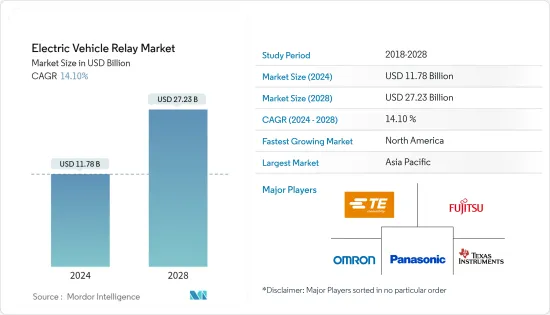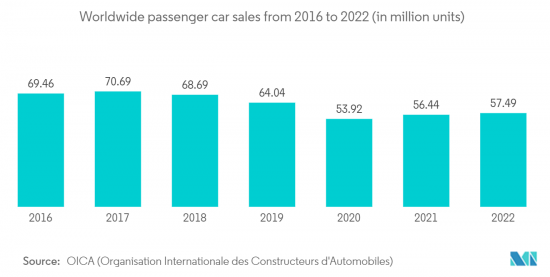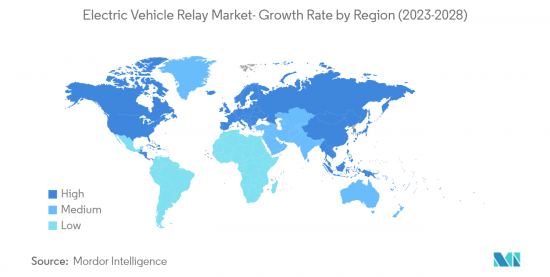
|
시장보고서
상품코드
1430509
전기자동차용 릴레이 : 시장 점유율 분석, 산업 동향, 성장 예측(2024-2029년)Electric Vehicle Relay - Market Share Analysis, Industry Trends & Statistics, Growth Forecasts (2024 - 2029) |
||||||
전기자동차용 릴레이 시장 규모는 2024년에 117억 8,000만 달러로 추정되고, 2028년에는 272억 3,000만 달러에 이를 것으로 예측되며, 예측기간 중(2024-2028년) CAGR은 14.10%로 성장할 전망입니다.

시장을 견인하는 것은 전기 자동차의 보급이 진행되고 있다는 것입니다. 또한 전기자동차 판매를 촉진하기 위한 정부의 이니셔티브와 CO2 배출량을 줄이기 위한 엄격한 정책이 시장의 성장을 뒷받침하고 있습니다. 따라서 다양한 자동차 응용 분야에서 이러한 기술이 널리 사용되고 있습니다.
예를 들어 국제에너지기구(IEA)에 따르면 2022년에는 세계에서 1,000만대 이상의 전기차가 판매되고, 2023년에는 추가로 35% 성장해 1,400만대에 달할 것으로 예상되고 있습니다.
릴레이는 자동차 충전기, 램프 제어, 각종 모터 제어, 히터 제어, 솔레노이드 제어 등 다양한 용도에서 중요한 역할을 합니다. 전기 자동차 수요가 높기 때문에 릴레이 제조업체는 제품의 기술적 진보에 주력하고 있습니다.
예를 들어, 텍사스 기기(TI)는 2022년 5월 전통적인 자동차 기계 릴레이를 대체하도록 설계된 2개의 솔리드 스테이트 릴레이 칩을 배포합니다.
아시아태평양이 가장 높은 점유율을 차지할 것으로 예상됩니다. 인도에서는 2022년에 총 83억 달러의 투자를 유치한 정부의 32억 달러의 인센티브 프로그램에 힘입어 EV와 부품의 제조가 활발해졌습니다. 태국과 인도네시아도 정책 지원 제도를 강화하고 있으며, EV의 보급을 목표로 하는 다른 신흥 시장 경제에 귀중한 경험이 될 수 있습니다.
따라서 위의 요인은 시장 성장을 가속할 가능성이 높습니다.
전기자동차용 릴레이 시장 동향
승용차가 시장에서 가장 높은 점유율을 차지
승용차는 세련된 디자인, 컴팩트한 사이즈, 경제적 가치 등의 특징으로 최근 몇 년동안 촉진요인들 사이에서 절대적인 인기를 얻고 있습니다. 승용차는 많은 선진국에서 가장 흔한 교통 수단입니다. 라이프스타일의 향상, 가처분 소득 증가, 브랜드 인지도의 향상, 경제성의 향상이 세계 고객의 기호의 변화를 가져오고, 승용차의 높은 매출로 이어지고 있습니다.
촉진요인의 편의성을 높이기 위해 승용차에 대한 릴레이 채용이 증가하고 있는 것은 조사 대상 시장의 성장에 긍정적인 영향을 미치고 있습니다. 이는 자동차의 안전성과 쾌적성을 높이는 부품에 대한 수요가 증가하고 있기 때문입니다. 자동차 안전성 평가를 공표하는 GNCAP(Global New Car Assessment Program) 등 정부의 다양한 시책과 자동차 충돌시험 기관으로 많은 자동차 구매자들 사이에서 고품질 자동차 및 기타 안전 기능 구축의 중요성에 대한 인식이 높아지고 있습니다.
이를 고려하여 자동차 제조업체는 자동차의 고급 안전 기능에 대한 수요 증가에 대응하기 위해 자동차의 고급 안전 기능에 더욱 힘을 쏟고 있습니다. 일반적인 액티브 세이프티 기능에는 안티록 브레이크 시스템(ABS), 일렉트로닉 안정성 제어(ESC), 타이어 공압 모니터링 시스템(TPMS), 차선 이탈 경보 시스템(LDWS) 등이 있습니다. 예를 들어 현대 모터스는 차량 안정성 관리 및 3점식 안전벨트와 같은 새로운 안전 기능을 차기 모델에 탑재합니다.
또한, 보다 안전한 자동차 생산을 촉진하는 정부 정책이 시장 성장을 뒷받침하고 있습니다. 예를 들어, 2023년 8월 도로교통 및 고속도로성은 Bharat New Car Assessment Programme(Bharat NCAP)를 시작했습니다. 이 프로그램은 인도에서 자동차의 안전 기준을 3.5톤으로 끌어올려 교통 안전을 향상시키는 정부의 헌신을 크게 앞당깁니다.
따라서 위의 요인은 시장 성장의 원동력이 되었습니다.

아시아태평양이 시장에서 높은 점유율을 차지
아시아태평양은 인도, 중국, 일본 등 주요 시장 수요 증가로 인해 예측 기간 동안 시장에서 현저한 점유율을 차지할 것으로 예상됩니다.
중국과 인도는 주요 자동차 소비국으로 전 세계적으로 자동차 수요의 큰 점유율을 차지하고 있습니다. 중간소득층 증가나 방대한 젊은이 인구 등의 요인이 왕성한 수요를 가져올 것으로 보입니다.
예를 들어, CEEW Centre for Energy Finance의 조사는 인도에서 2030년까지 전기 자동차에 2,060억 달러의 비즈니스 기회가 있다고 인식하고 있습니다.
인도나 중국과 같은 국가 정부는 전기 자동차 판매를 촉진하고 전기 자동차에 대한 이니셔티브를 도입하여 전기 자동차 산업의 세계 리더가 되는 정책에 주력하고 있습니다. 또한 정부는 전기 자동차 수요를 늘리기 위해 여러 프로그램과 인센티브를 개발하고 있습니다. 자동차 제조업체는 전기 자동차 및 관련 인프라의 연구 개발에 투자하고 있습니다.
인도 정부는 저렴한 도로 사용료, 스크랩, 개조 인센티브를 실시함으로써 2030년까지 30%의 EV 보급을 전망하고 있습니다.
또한 석유수입 증가 및 공해 증가로 각국 정부는 전자 이동성으로의 전환을 서두르고 있습니다.
세계에서 전기 자동차가 판매되고, 전기 자동차 수요도 비약적으로 성장하고 있습니다. 이 시나리오를 고려하면 시장이 성장할 것으로 예상됩니다.

전기자동차용 릴레이 산업 개요
전기자동차 릴레이 시장은 세계적으로 그리고 지역적으로 확립된 기업에 의해 통합되고 주도되고 있습니다. 각 회사는 시장에서의 지위를 유지하기 위해 신제품 출시 및 제휴 등의 전략을 채용하고 있습니다. 예를 들면
2023년 8월 LS Electric Co. 산하의 전기자동차(EV) 부품에 특화된 자회사인 LS e-Mobility Solutions는 현대기아차가 제조하는 전기자동차에 릴레이를 공급하는 2,500억원(1억 8,700만 달러)공급 계약을 획득했습니다. 이 계약은 LS 일렉트릭이 공식적으로 발표한 것으로, LS e-Mobility Solutions의 지사인 LS Mobility Solutions가 현대기아차와 계약을 맺은 것을 강조했습니다. 이 계약은 전기 자동차에 EV 릴레이를 공급하는 것입니다. 부품은 2025년 전반에 납품될 예정입니다.
이 시장의 주요 기업으로는 Panasonic Corporation, Texas Instruments, Omron Corporation, Fujitsu Limited 등이 있습니다.
기타 혜택 :
- 엑셀 형식 시장 예측(ME) 시트
- 3개월간의 애널리스트 서포트
목차
제1장 서론
- 조사의 성과
- 조사의 전제
- 조사 범위
제2장 조사 방법
제3장 주요 요약
제4장 시장 역학
- 시장 개요
- 시장 성장 촉진요인
- 보다 안전한 자동차에 대한 수요 증가
- 시장 성장 억제요인
- 릴레이의 높은 제조 비용
- Porter's Five Forces 분석
- 공급기업의 협상력
- 구매자 및 소비자의 협상력
- 신규 참가업체의 위협
- 대체품의 위협
- 경쟁 기업간 경쟁 관계의 강도
제5장 시장 세분화
- 추진력 유형별
- 배터리 전기 자동차(BEV)
- 하이브리드 전기자동차(HEV)
- 제품 유형별
- PCB 릴레이
- 플러그인 릴레이
- 차량 유형별
- 승용차
- 상용차
- 용도별
- 전자 파워 스티어링
- 안티록 브레이크 시스템
- 도어록
- 파워 윈든
- 에어컨
- 기타 용도
- 지역별
- 북미
- 미국
- 캐나다
- 기타 북미
- 유럽
- 독일
- 영국
- 프랑스
- 스페인
- 기타 유럽
- 아시아태평양
- 인도
- 중국
- 일본
- 한국
- 기타 아시아태평양
- 세계 기타 지역
- 남미
- 중동 및 아프리카
- 북미
제6장 경쟁 구도
- 벤더의 시장 점유율
- 기업 프로파일
- Panasonic Corporation
- Omron Corporation
- Fujitsu Limited
- Texas Instruments Incorporated
- TE Connectivity Ltd.
- Denso Corporation
- HELLA GmbH & Co.
- Ningbo Forward Relay Corp. Ltd.
- Jiangxi Weiqi Electric Co. Ltd.
제7장 시장 기회 및 앞으로의 동향
AJY 24.02.28The Electric Vehicle Relay Market size is estimated at USD 11.78 billion in 2024, and is expected to reach USD 27.23 billion by 2028, growing at a CAGR of 14.10% during the forecast period (2024-2028).

The market is expected to be driven by the rising adoption of electric vehicles. Moreover, initiatives taken by the government to boost sales of electric vehicles and stringent policies to reduce CO2 emissions will drive the market growth. Hence, there has been widespread utilization of these technologies in various automotive applications.
For instance, according to the International Energy Agency, more than 10 million electric cars will be sold worldwide in 2022, and sales are expected to grow by another 35% to reach 14 million in 2023.
Relay plays an important role in various kinds of applications such as on-board chargers, lamp controls, various motor controls, heater controls, and solenoid controls. With the high demand for electric vehicles, relay manufacturers are focusing on technological advancements in their products.
For example, in May 2022, Texas Instruments (TI) is rolling out two solid-state relay chips designed to replace traditional automotive mechanical relays.
Asia Pacific is expected to hold the highest share. In India, EV and component manufacturing is ramping up, supported by the government's USD 3.2 billion incentive program that has attracted investments totaling USD 8.3 billion in 2022. Thailand and Indonesia are also strengthening their policy support schemes, potentially providing valuable experience for other emerging market economies seeking to foster EV adoption.
Thus, the above factors will likely drive market growth.
Electric Vehicle Relay Market Trends
Passenger Car holds Highest Share in the Market
Passenger cars have gained immense popularity among drivers over the past few years due to features such as stylish design, compact size, and economic value. Passenger cars are the most common mode of transportation in numerous advanced countries. The improving lifestyles, increasing disposable income, raising brand awareness, and economy are leading to customer preference changes across the globe, resulting in high sales of passenger cars.
The increasing adoption of relays in passenger vehicles for driver convenience is favorably impacting the growth of the market studied. This is also attributed to the rising demand for vehicle safety and comfort components. Various Government measures and car crash test organizations like the Global New Car Assessment Program (GNCAP), which publishes car safety ratings, have created awareness among many car buyers regarding the importance of building quality vehicles and other safety features.
Considering this, the automakers are focusing more on advanced safety features in vehicles to cater to the rising demand for advanced safety features in vehicles. Some of the common active safety features include an anti-lock braking system (ABS), Electronic Stability Control (ESC), Tyre Pressure Monitoring System (TPMS), Lane Departure Warning System (LDWS), etc. For example, Hyundai Motors launches new safety features like Vehicle Stability Management and 3-point seatbelts in its upcoming models.
Moreover, government policies to promote the production of much safer cars drive the market growth. For instance, in August 2023 Ministry of Road Transport & Highways launched the Bharat New Car Assessment Programme (Bharat NCAP). This program is a significant step forward in the Government's commitment to improving road safety by raising the safety standards of motor vehicles to 3.5 tons in India.
Thus, the above factors drive market growth.

Asia-Pacific holds Highest Share in the Market
The Asia-Pacific region is expected to hold a notable share of the market during the forecast period owing to rising demand from key markets like India, China, Japan, and others.
China and India are considered to be the major automotive consumers and hold a significant share of automotive demand across the world. Factors such as rising middle-class income and a huge youth population will result in strong demand.
For instance, A study by the CEEW Centre for Energy Finance recognized a USD 206 billion opportunity for electric vehicles in India by 2030.
The Governments of countries like India and China are focusing on policies to promote sales of electric vehicles and become a worldwide leader in the EV industry by introducing Initiatives for electric vehicles. Moreover, the Government has developed several programs and incentives to increase demand for electric cars. Automotive manufacturers are investing in the R&D of electric vehicles and related infrastructure.
The Government of India is projecting 30% EVs by 2030 by implementing cheaper road fees, scrapping, and refit incentives.
Moreover, the growing expense of oil imports and increased levels of pollution make governments expedite the transition to e-mobility.
With the growth of electric vehicle sales across the globe, the demand for electric vehicles really will also grow exponentially, and companies are focusing on increasing their production capacity to cater to the high demand. Considering the scenario, the market is expected to grow.

Electric Vehicle Relay Industry Overview
The electric vehicle relay market is consolidated and led by globally and regionally established players. The companies adopt strategies such as new product launches and collaborations to sustain market positions. For instance
In August 2023, LS e-Mobility Solutions, a subsidiary focused on electric vehicle (EV) components under LS Electric Co., secured a supply contract valued at 250 billion won (USD187 million) to provide relays for electric vehicles manufactured by Hyundai Motor Co. and Kia Corp. The agreement was officially announced by LS Electric, highlighting that LS Mobility Solutions, a branch of LS e-Mobility Solutions, has entered into a contract with Hyundai-Kia Motors. The agreement entails the supply of EV relays for electric vehicles. The components are scheduled for delivery in the first half of 2025.
Some of the major players in the market include Panasonic Corporation, Texas Instruments, Omron Corporation, and Fujitsu Limited.
Additional Benefits:
- The market estimate (ME) sheet in Excel format
- 3 months of analyst support
TABLE OF CONTENTS
1 INTRODUCTION
- 1.1 Study Deliverables
- 1.2 Study Assumptions
- 1.3 Scope of the Study
2 RESEARCH METHODOLOGY
3 EXECUTIVE SUMMARY
4 MARKET DYNAMICS
- 4.1 Market Overview
- 4.2 Market Drivers
- 4.2.1 Increasing demand for safer vehicles
- 4.3 Market Restraints
- 4.3.1 High Production Cost of Relays
- 4.4 Porter's Five Forces Analysis
- 4.4.1 Bargaining Power of Suppliers
- 4.4.2 Bargaining Power of Buyers/Consumers
- 4.4.3 Threat of New Entrants
- 4.4.4 Threat of Substitute Products
- 4.4.5 Intensity of Competitive Rivalry
5 MARKET SEGMENTATION
- 5.1 Propulsion Type
- 5.1.1 Battery Electric Vehicle (BEV)
- 5.1.2 Hybrid Electric Vehicle (HEV)
- 5.2 Product Type
- 5.2.1 PCB Relay
- 5.2.2 Plug-in Relay
- 5.3 Vehicle Type
- 5.3.1 Passenger Car
- 5.3.2 Commercial Vehicle
- 5.4 Application
- 5.4.1 Electronic Power Steering
- 5.4.2 Anti-Lock Braking System
- 5.4.3 Door Lock
- 5.4.4 Power Windon
- 5.4.5 Air-Conditioner
- 5.4.6 Other Applications
- 5.5 Geography
- 5.5.1 North America
- 5.5.1.1 United States
- 5.5.1.2 Canada
- 5.5.1.3 Rest of North America
- 5.5.2 Europe
- 5.5.2.1 Germany
- 5.5.2.2 United Kingdom
- 5.5.2.3 France
- 5.5.2.4 Spain
- 5.5.2.5 Rest of Europe
- 5.5.3 Asia-Pacific
- 5.5.3.1 India
- 5.5.3.2 China
- 5.5.3.3 Japan
- 5.5.3.4 South Korea
- 5.5.3.5 Rest of Asia-Pacific
- 5.5.4 Rest of the World
- 5.5.4.1 South America
- 5.5.4.2 Middle East and Africa
- 5.5.1 North America
6 COMPETITIVE LANDSCAPE
- 6.1 Vendor Market Share
- 6.2 Company Profiles
- 6.2.1 Panasonic Corporation
- 6.2.2 Omron Corporation
- 6.2.3 Fujitsu Limited
- 6.2.4 Texas Instruments Incorporated
- 6.2.5 TE Connectivity Ltd.
- 6.2.6 Denso Corporation
- 6.2.7 HELLA GmbH & Co.
- 6.2.8 Ningbo Forward Relay Corp.Ltd.
- 6.2.9 Jiangxi Weiqi Electric Co. Ltd.



















